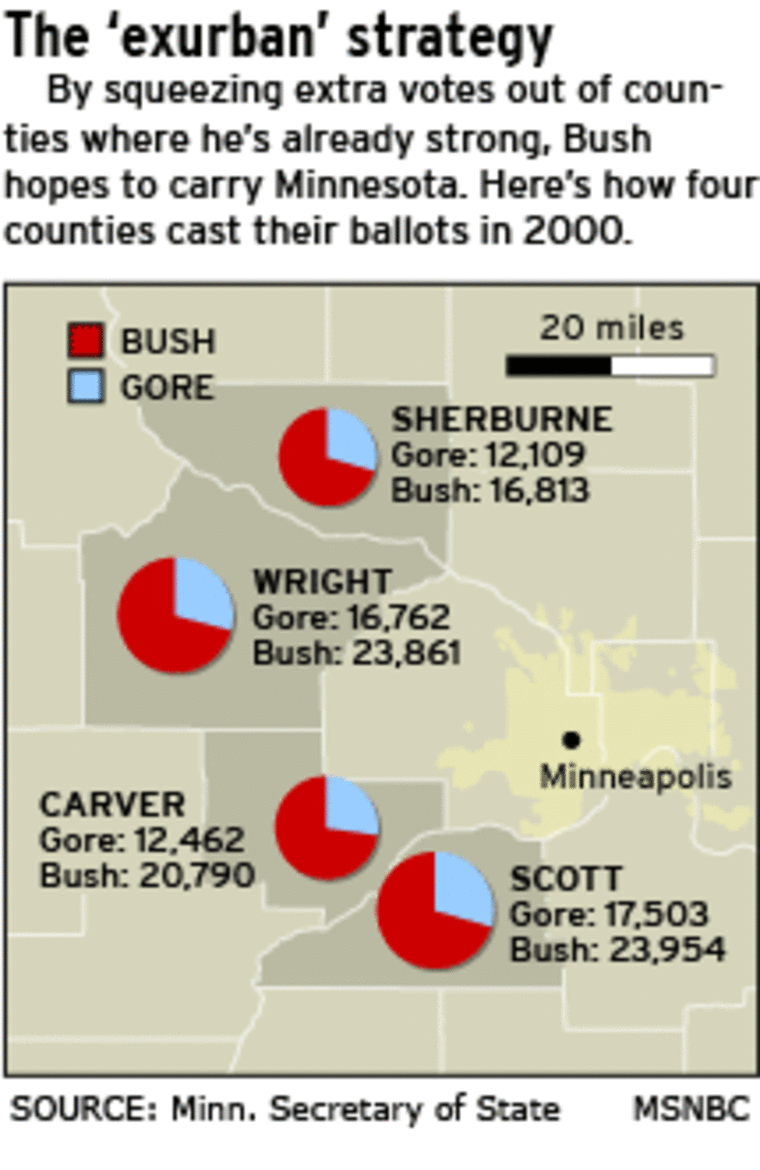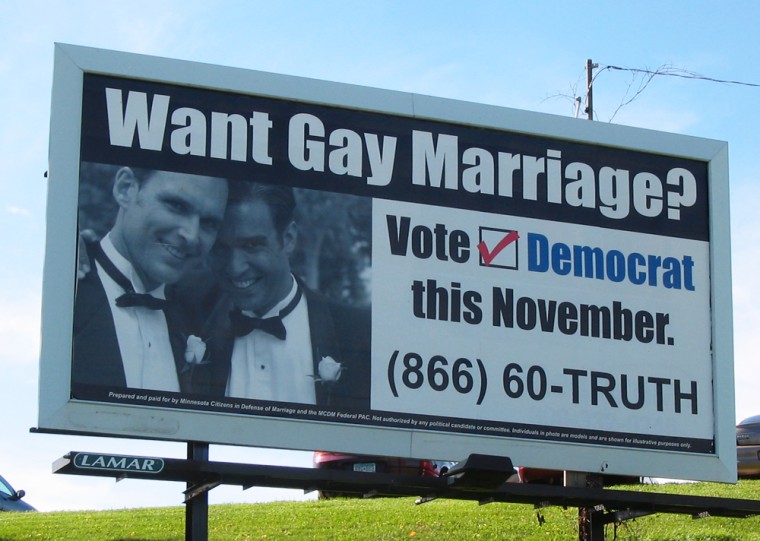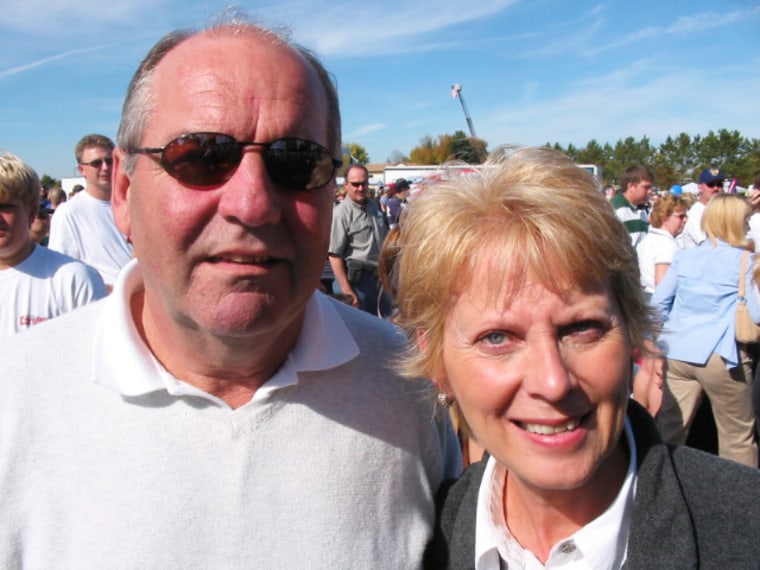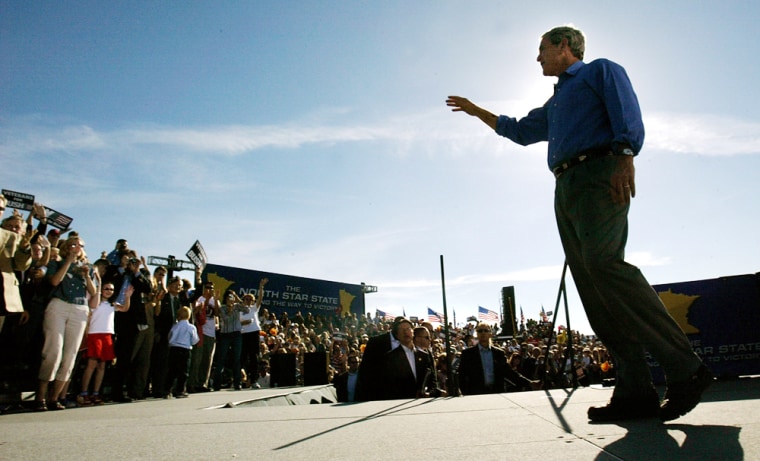President Bush came to Carver County, Minnesota over the weekend and, in this, his sixth campaign visit to the state, the message was clear: He intends to win this state, which hasn’t gone Republican in a presidential election since 1972, and he’s going to try to do it largely based on his strength in the ring of suburbs around Minneapolis.
On a warm Indian summer afternoon, Bush fired up an already roaring crowd of some 10,000 people Saturday in a field behind the elementary school in Chanhassen.
“Turn out the vote! Get people to the polls!” Bush exhorted the cheering crowd. Later he promised, “I’m looking forward to coming back to Minnesota before Election Day,” a signal with 23 days of campaigning left of just how serious he is about winning the state.
Four years ago, Bush carried Carver County with nearly 60 percent of the vote. In three other suburban counties flanking Minneapolis, he won with similarly big percentages; in two other suburban counties, Anoka and Dakota, he won by slim margins.
Carver County’s population grew by nearly 50 percent from 1990 to 2000 and by another 12 percent from 2000 to 2003, according to the Census Bureau. This is an affluent, but not ostentatious, slice of newer suburbia where many of the homes were built in the 1980s and 1990s. You can buy a four-bedroom home with a two-car garage here for $350,000.
“It has a lot of parks, we have lots of young families with small children, it’s a very safe community,” said Brian Lundquist, who serves on the Chanhassen city council and is the co-chairman of the Bush-Cheney volunteer effort in Carver County.
It is exactly the kind of “exurb” — or newer suburb — that Bush aide Karl Rove had in mind as he sketched a strategy for reporters back in August, when he pointed out that in older suburbs, “you may have as many as 88 percent of eligible Bush supporters, and likely Republicans, already registered to vote. But in the exurbs that number is no more than 81 percent.”
Upon such slender differences may hinge the outcome here in Minnesota, and thus in the electoral vote that will determine who the next president is.
If Bush were to lose the 20 electoral votes of Ohio, where Democrat John Kerry is pressing him hard, he could make up that deficit with victories here in Minnesota, which has 10 electoral votes, and next door in Wisconsin, which adds another 10.

Republicans see the state of Hubert Humphrey, Eugene McCarthy, Walter Mondale and Paul Wellstone as heading inexorably their way and they have two big wins in 2002 — Tim Pawlenty’s election as governor and Norm Coleman’s as senator — to prove it.
“This is a state that has reached its limit of classic liberalism and it’s adjusting to a politically competitive state,” Pawlenty told MSNBC.com during the Republican convention last month in New York. “The great thing about the Minnesota Democrats, from a Republican standpoint, is that they are incapable of Clintonizing. They just will not allow themselves to go to the center; they won’t embrace centrist Democratic approaches.”
He added, “In the end, Kerry is not going to be able to Clintonize. His record is too long, too extreme to the left. He is not going to be able to successfully present himself as a centrist, common-sense Democrat.”
Clinton and Gore's record
Clinton carried Minnesota twice by comfortable margins. In 2000, Al Gore carried Minnesota by 2.4 percentage points.
On paper, Bush’s deficit is about 58,000 votes.
The challenge with the exurban voter and potential Bush backer, Rove said, “is to get them motivated to participate, to get them literally physically registered, and then getting them out to vote.”
Since these counties are growing rapidly, there ought to be thousands of extra Bush votes in the Minneapolis/St. Paul exurbs on Election Day: A combination of more voters, higher turnout, and nudging the Bush percentage from 60 percent to, say 63 percent, in Carver County and the other suburban counties could put him within striking distance of carrying Minnesota.
But for Republicans, there is a problem with the Minnesota arithmetic: Ramsey County and Hennepin County, the two counties that include St. Paul and Minneapolis, account for one-third of the state’s votes. In Hennepin, Gore won 54 percent of the vote; in Ramsey, he did even better, winning 57 percent.
Are there enough Bush voters in the exurban ring to offset the enormous Democrat edge in the state’s two biggest counties?

Possibly not: There were 200,000 more Democratic voters in Hennepin and Ramsey than there were Republican voters in the six suburban and exurban counties in the Minneapolis metro area that Bush won in 2000.
Bush may offset part of the Democratic urban edge by doing well in rural western and southern Minnesota, as he did four years ago.
A key imponderable: This was one of Ralph Nader’s strongest states in 2000. What choice will the 127,000 Minnesotans who voted for Nader last time make this year? Nader is on the Minnesota ballot this November.
Sign of weakness?
Roy Temple, Kerry’s state director in Minnesota, saw Bush’s visit to Chanhassen as a sign of weakness.
“George Bush was in here in the Second Congressional District, in a district represented by a Republican, in a county where he got 60 percent,” Temple explained. “John Edwards is here (Sunday) in the Third Congressional District, also a district represented by a Republican where the Democrats did not carry it in 2000. So we’re on the offense here. We are to going places that are not necessarily the center of our base at this point in the election, still bringing new people in to fold, and he’s trying to run up the score in places that he feels safe.”
Kerry, like Bush, has made six campaign trips to Minnesota since clinching the nomination
Temple said Republican strategists were “fighting the last battle, they’re playing a strategy that worked quite effectively for them in 2002. It was a far more effective strategy in a non-presidential year when the turnout was far more elastic than it will be in a presidential year.”
Temple expects turnout on Nov. 2 to approach 80 percent statewide and added, “we have very aggressive efforts to drive turnout in heavily Democratic areas.”
His forecast: “I don’t think Karl Rove is putting any money on (the idea) that he is going to win Minnesota. And if he wants a friendly wager, I’ll make it.”
But despite Temple’s odds, two of the Bush loyalists who turned out at the elementary school field in Chanhassen to hear him Saturday voiced support for his commitment to pacifying Iraq and skepticism of the news media coverage of events there.

Pat’s husband, Dick, added, “There is a lot of progress in Iraq, even though it is not shown in the media.”
Pat Schutrop said traditional marriage is another one of her concerns. Using veiled language, Bush alluded Saturday to the possibility of court rulings that might force Minnesota and other states to accept same-sex marriage.
“We stand for marriage and family, which are the foundation of our society,” he told the Chanhassen crowd.
Making the case against same-sex marriage less subtly than Bush is a billboard in the town of St. Peter, about an hour’s drive south of Minneapolis in Republican-leaning Nicollet County.
“Want Gay Marriage? Vote Democrat this November.”
Smiling down from the billboard are two men with their arms around each other and wearing tuxedos.
The billboard urges voters to call the Minnesota Citizens in Defense of Marriage toll-free number, which gives a recorded message on “why the Democratic Party has become the party of gay marriage,” adding that Kerry was one of only 14 senators to vote against the Defense of Marriage Act in 1996.
